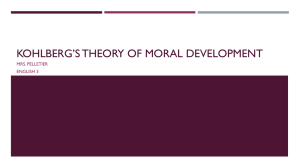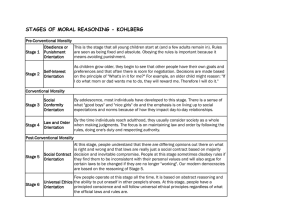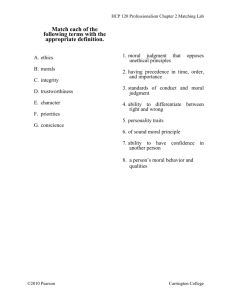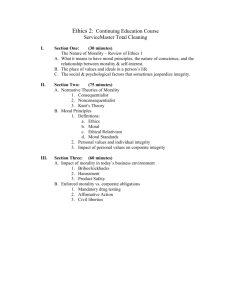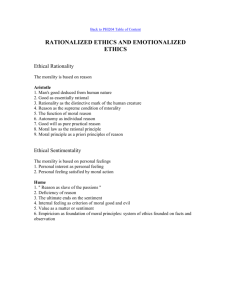Adolescent Development Key Concepts Puberty Primary and
advertisement
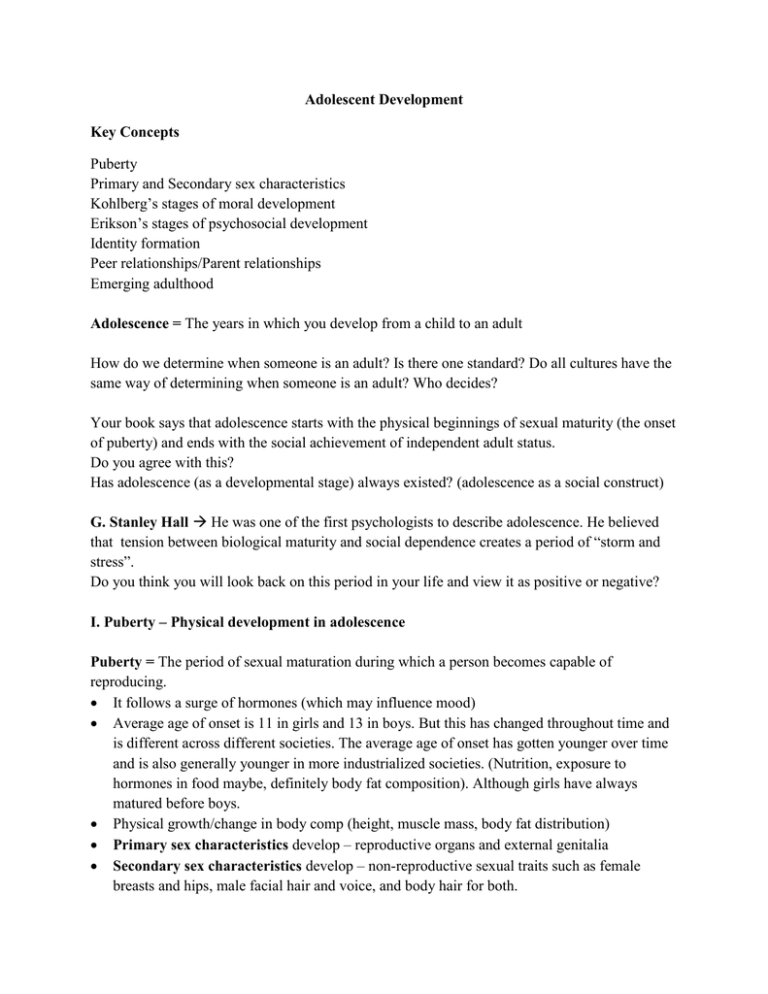
Adolescent Development Key Concepts Puberty Primary and Secondary sex characteristics Kohlberg’s stages of moral development Erikson’s stages of psychosocial development Identity formation Peer relationships/Parent relationships Emerging adulthood Adolescence = The years in which you develop from a child to an adult How do we determine when someone is an adult? Is there one standard? Do all cultures have the same way of determining when someone is an adult? Who decides? Your book says that adolescence starts with the physical beginnings of sexual maturity (the onset of puberty) and ends with the social achievement of independent adult status. Do you agree with this? Has adolescence (as a developmental stage) always existed? (adolescence as a social construct) G. Stanley Hall He was one of the first psychologists to describe adolescence. He believed that tension between biological maturity and social dependence creates a period of “storm and stress”. Do you think you will look back on this period in your life and view it as positive or negative? I. Puberty – Physical development in adolescence Puberty = The period of sexual maturation during which a person becomes capable of reproducing. It follows a surge of hormones (which may influence mood) Average age of onset is 11 in girls and 13 in boys. But this has changed throughout time and is different across different societies. The average age of onset has gotten younger over time and is also generally younger in more industrialized societies. (Nutrition, exposure to hormones in food maybe, definitely body fat composition). Although girls have always matured before boys. Physical growth/change in body comp (height, muscle mass, body fat distribution) Primary sex characteristics develop – reproductive organs and external genitalia Secondary sex characteristics develop – non-reproductive sexual traits such as female breasts and hips, male facial hair and voice, and body hair for both. Sexual attraction and beginnings of sexual behavior appear before puberty Puberty landmark for girls – Puberty begins with breast development (average age 10) but menarche (the first menstrual period) is the major landmark. Puberty landmark for girls – Spermarche (first ejaculation, usually a nocturnal emission or “wet dream”) Again, sequence is more predictable than timing. There is some variation in timing but not in order at which things occur. Variations in timing has no effect on the end result (for examples, getting breasts earlier doesn’t lead to having bigger breasts as an adult and hitting your growth spurt earlier doesn’t have any impact on your adult height) but it can have lasting psychological consequences. These are different for girls and boys. Early development in boys Being stronger and more athletic and mature looking earlier on tends to make them more popular, self-assured, athletic, and independent. But this popularity also puts them at increased risk for alcohol use, delinquency, and premature sexual activity. Early development in girlsMore stressful, embarrassing, may lead to self-consciousness or teasing, or low self-esteem, or it may lead girls to behaviors which they are not yet emotionally mature enough for, namely associating with older adolescents and premature sexual activity. II. Neural Development in adolescence Neural connections have been increasing throughout childhood. Adolescence is a period of selective pruning of unused or redundant neurons and connections. Frontal lobes continue maturing throughout, until age 25, and more myelin is made. Frontal lobe maturation leads to improved judgement, impulse control, and the ability to plan or the long term and weigh future consequences BUT… The limbic system (emotion, memory) is also still maturing in adolescence too, and it does this faster than the frontal lobes are developing, so adolescents have more intense emotional behavior before they have fully developed impulse control and judgment capabilities. (Which explains some of the impulsiveness, risky behavior, and mood swings associated with adolescence) Heavy drinking during adolescence slows brain development. Since this is a “critical period” for these developments, development doesn’t just pick up when the alcohol abuse is removed, or just take longer with the same end result. It is now or never. III. Adolescent Social Development In contrast to the once-prevailing view that life patterns are set in early childhood, Erik Erikson proposed a life-span theory of development. According to Erikson, people mature through 8 psychosocial stages, each marked by a crisis that has to be resolved. Stages 1 to 4 unfold in infancy and childhood; stage 4, in adolescence; and stages 6 to 8 in the years of adulthood. (Adolescence- teens to early 20’s, Early adulthood – 20’s- 40’s, Middle age – 40’s to 60’s, Late adulthood – 60’s and up). Forming and Identity Trying out different “selves”, figuring out who is the “real you”. We may have a different “self” for different settings (at home and with friends or at school) Two situations overlap discomfort This discomfort and questions about who is the true self underlies this process, and eventually, most emerge with a unified self that is consistent and comfortable Identity – Our sense of self. According to Erikson, the adolescent’s task is to solidify a sense of self by testing and integrating various roles. Social identity – The “we” aspect of our self-concept, the part of our identity that comes from our group membership, which itself forms around their distinctiveness, how we differ from those around us. Some simply adopt parent’s values or others form identity in opposition to parent’s values Some form identity around a peer group Most develop a sense of contentment, an identity they are satisfied with, but some have trouble ever “finding themselves” College provides another chance to try out new roles Identity becomes more personalized IV. Cognitive development Developing Reasoning Power According to Piaget, adolescents become capable of Formal Operational thinking. They become capable of abstract reasoning, able to see things from others’ perspectives and imagine what they are feeling, and able to think about hypothetical situations or imagined realities. Being able to imagine what others are thinking leads to imagining, and being concerned with what they think about us (self-consciousness). Being able to imagine hypotheticals and imagined realities allows us to imagine what is ideally possible and to compare that with the imperfect reality of society, parents, and self. Being able to reason abstractly, and not just concretely, allows us to ponder and become interested in concepts like human nature, good and evil, truth and justice, and to get a deeper conception of God, existence, sense of purpose. Being able to reason hypothetically and deductively allows us to think critically, detect inconsistencies in others’ reasoning and spot hypocrisy. What do you think is the consequence of having a period of time where we are capable of thinking in this way but at the same time are fairly shielded from some of the harshest aspects of reality? V. Moral Development Being able to discern right from wrong and the development of moral character are two of the crucial tasks/challenges of childhood and adolescence. Piaget, Kohlberg Moral development is contingent on cognitive development/reasoning capabilities. Piaget had a theory of moral development in addition to his theory of cognitive development. It is similar to Lawrence Kohlberg’s theory of moral development and really, Kohlberg’s is the more important one to know. Piaget focused mostly on moral understanding, rather than moral behavior. How do children/adolescents of different ages understand right and wrong? In one study, he asked young and older children the question of which situation was ‘naughtier’ – an unintentional big damage act or an intentional, small damage act? A child is called to dinner and when they open the door to the kitchen, a hidden tray with 15 cups is knocked over. In the second situation, a child is trying to get to some forbidden jam in the kitchen and in the process, knocks over 1 cup. The younger kids say the 15-cup devastation is worse while older kids say 1-cup devastation is worse. The younger kids base their decision on the objective fact of the amount of damage done while the older kids are able to interpret the subjective information about intent. When he would ask kids if lying was wrong, younger kids (less than 7 years) always considered lying wrong, regardless of the circumstances. Younger children also accept parental authority as the criteria of what is moral – so frequently their answers about what is ‘bad’ reflects what their parents consider ‘bad’. Piaget’s model of moral development consists of three stages. The first, moral realism, is where the child does not question authority and has very rigid rules regarding morality. In this stage, the child sees morality as black and white – there are no special circumstances for lying, stealing, cheating – its all just BAD! In the second stage, morality of cooperation, the child adopts a belief in equal treatment and reciprocity. There is a very strong belief in taking turns. There may still be issues with the idea that those who need the most should get the most – rather than everyone getting the exact same amount. The third stage is moral relativism. In this stage, some actions can be judged as either good or bad depending on the particular situational circumstances and the events that lead to the action. The adolescent can take into account intent and motives in their reasoning about morality. Lawrence Kohlberg’s theory of moral development Kohlberg agreed with Piaget that morality is contingent on cognitive development. He sought to describe the development of moral reasoning by presenting children, adolescents, and adults with different moral dilemmas and asking them about whether the actions involved are right or wrong, then analyzing their answers to see if there were different stages in which moral reasoning differed and what characterized the moral reasoning of each stage. Moral reasoning = the thinking that occurs as we consider right and wrong. He proposed that we pass through three basic levels of moral thinking (this three levels or stages can also be subdivided into six sub levels). The classic Kohlberg dilemma: A woman is near death from a special kind of cancer. There is one drug that the doctors think might save her. It is a form of radium that a pharmacist in the same town has recently discovered. The drug is expensive to make, but the pharmacist is charging 5 times what it costs him to make the drug. The sick woman’s husband has gone to everyone he knows to borrow the money, but he can only get together about half of what the drug costs. He tells the pharmacist that his wife is dying and asks him to sell it cheaper or let him pay later. But the pharmacist says that he won’t do that. The sick wife’s husband gets desperate and breaks into the pharmacy to steal the drug. Should the husband have done this? Why? Just as in cognitive development, stages cannot be skipped; each provides a new and necessary perspective, more comprehensive and differentiated than its predecessors but integrated with them. This is true as far as the level of moral reasoning people are capable of, however, as your book points out, adults may sometimes use pre-conventional reasoning, even though they should be capable of more advanced levels of reasoning. So, in reality, we may not always use the same type of moral reasoning in every situation. Pre-Conventional (before age 9) - Obedience and punishment orientation (How can I avoid punishment?) - Self-interest orientation (What's in it for me?) Conventional (by early adolescence) - Interpersonal accord and conformity (Social norms, The good boy/good girl attitude) - Authority and social-order maintaining orientation (Law and order morality) Post-Conventional (later adolescence and adulthood) - Social contract orientation - Universal ethical principles (Principled conscience) 1. Pre-conventional Moral Reasoning. Morality focuses on self-interest. Children in this stage obey rules to avoid punishment or to gain concrete rewards. Morality is not yet internalized. Obedience and punishment oriented The child has not internalized moral values and is totally guided by external consequences, rewards and punishments. They judge the morality of an action by its direct consequences. Children obey because adults tell them to and they know that they will be punished if they don’t and/or rewarded if they do. For example, an action is perceived as morally wrong because the perpetrator is punished. The worse the punishment for the act is, the more "bad" the act is perceived to be. They might answer the earlier example by saying that the husband shouldn’t have stolen the drug because he will go to jail. Self-interest oriented Moral thinking in this level is based on self-interest. It espouses the "what's in it for me" position, in which right behavior is defined by whatever is in the individual's best interest. If it is in the best interest to obey, either because a reward will be gained or because punishment will be avoided, then the child will obey. Stage two reasoning shows a limited interest in the needs of others, but only to a point where it might further the individual's own interests. 2. Conventional Morality Conventional morality is characterized by an acceptance of society's conventions concerning right and wrong. Morality is still an external force. Good girl/good boy mentality In this stage, rather than focusing on rewards and punishments, they are focusing on receiving approval and avoiding disapproval from authority figures (parents, teachers). They try to be a "good boy" or "good girl" to live up to expectations of these roles, having learned that there is inherent value in doing so. In answering the above question, they may say that the husband should have stolen the drug because that is what is expected of him as a husband. Law and order mentality Morality focuses on upholding laws and social rules, simply because they are the laws and rules. Laws and rules are recognized as necessary to maintain social order. Actions are judged as right or wrong based on whether or not they follow laws, rules, or norms. At this level an individual obeys rules and follows society's norms even when there are no consequences for obedience or disobedience. Adherence to rules and conventions is somewhat rigid, however, and a rule's appropriateness or fairness is seldom questioned. They may respond to the example by saying that it may be good for the husband to want to steal to help his wife, but it is still wrong. Post-conventional Actions are judged as right because they flow from people’s rights or from self-defined, basic ethical principles. Requires abstract thinking. Morality is internalized and is not on others’ standards. People develop their own abstract principles of right and wrong that may be separate from legal or social dictates. The value of laws and rules can be questioned and some values (such as freedom) are more important than the law. It is okay for people to disobey laws that are unjust or inconsistent with their moral principles Moral behavior/actions are right because it they are right, and not because they are instrumental, expected, legal, or previously agreed upon. Social contract orientation Morality is seen as being a social contract – “I will act in the best interests of others and myself in such a manner that I don’t hurt others unnecessarily.” They see a justification for technically illegal behavior when it is in the best interest of society to save a human life, for example. Laws are regarded as social contracts rather than rigid edicts. Those that do not promote the general welfare should be changed when necessary to meet “the greatest good for the greatest number of people”.[ Universal Human rights perspective Moral reasoning is based on abstract reasoning using universal ethical principles. Laws are valid only insofar as they are grounded in justice, and a commitment to justice carries with it an obligation to disobey unjust laws. They would see the husband as evaluating and attempting alternatives but recognizing that the wife’s life is more important than the law. Does everyone reach this last level of moral reasoning? What are some problems with Kohlberg’s and Piaget’s views on moral reasoning? They are tied to cognitive ability. Does this mean that someone with disability, who has limited cognitive abilities is incapable of higher levels of moral reasoning? It is value-based. o Carol Gilligan argued that it is biased toward men because it focuses on actions and not on the emotions. o Moral feelings do not fit into Kohlberg (or Piaget) well o Others argue that it is biased toward value systems of European, individualistic cultures, because they emphasize individual action, and biased against the moral reasoning of collectivist societies like China and India. Moral Feeling An alternative explanation of morality Could morality really be run by moral emotions? The mind makes moral judgments quickly and automatically. Moral actions (either performing or witnessing) makes us feel good and immoral ones fill us with disgust and degradation. Jonathan Haidt’s Social Intuitionist account of morality moral feelings precede moral reasoning. Moral reasoning aims to convince ourselves of what we intuitively feel to be right. Support, Imaging study Imagine a moral paradox, kill one to save five. If the situation requires us to actually push a stranger onto the track, emotional areas of the brain light up but not if the situation just requires us to pull a switch in order to kill one and save five. The engagement of emotions alters people’s moral judgment (what they perceive to be the right, morally justifiable action in the situation).
